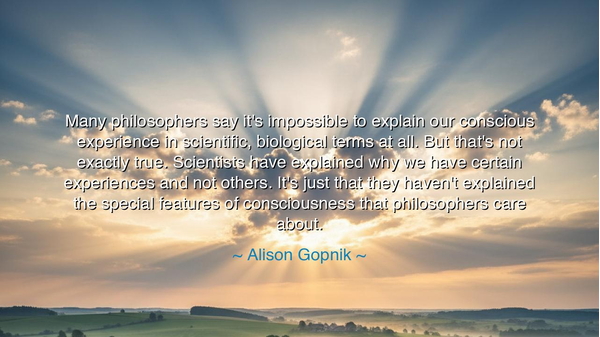
Many philosophers say it's impossible to explain our conscious
Many philosophers say it's impossible to explain our conscious experience in scientific, biological terms at all. But that's not exactly true. Scientists have explained why we have certain experiences and not others. It's just that they haven't explained the special features of consciousness that philosophers care about.






"Many philosophers say it's impossible to explain our conscious experience in scientific, biological terms at all. But that's not exactly true. Scientists have explained why we have certain experiences and not others. It's just that they haven't explained the special features of consciousness that philosophers care about." — thus spoke Alison Gopnik, a scholar of mind and child, who seeks to bridge the ancient gulf between science and philosophy, between the tangible and the ineffable. In these words, she calls us to humility and wonder — to recognize both the reach and the limits of human understanding. She honors the power of science, which has illuminated the workings of the brain, yet reminds us that even as we chart the lightning of neurons, the deeper mystery — consciousness itself — remains, like the horizon, ever retreating as we approach.
From the beginning of time, humankind has gazed inward and asked the oldest question: What is it that knows? The ancients named it soul; the mystics, spirit; the philosophers, mind. And though today we dress our inquiry in the language of neuroscience and biology, the question is the same: How does matter awaken into awareness? Gopnik speaks to this eternal tension — that science can describe the mechanisms of experience, but not yet the essence. We can say why the eye sees red instead of blue, or how the brain processes pain or joy. Yet we cannot say why seeing red feels like fire, or why sorrow weighs upon the chest like stone. This, the philosophers call the hard problem of consciousness — the bridge between matter and meaning, between neurons and the ineffable glow of being.
The origin of Gopnik’s insight lies in her lifelong study of the mind — especially the minds of children, whose curiosity reflects the earliest state of consciousness itself. In their wonder, she sees the blueprint of all inquiry. Science, she reminds us, was born not from certainty but from awe — the same awe that a child feels gazing at the sky or pondering a shadow. In her words, she challenges both the philosopher who despairs of explanation and the scientist who believes all mysteries can be conquered. She stands between them, like a mediator at dawn, saying: both are right, and both are incomplete.
To understand her teaching, consider the story of René Descartes, who centuries ago declared, “I think, therefore I am.” Descartes sought to find truth through reason alone, separating mind from body. Yet in doing so, he created a rift that endures to this day — the divide between the inner world of experience and the outer world of matter. Since his time, countless thinkers have tried to bridge that chasm. The scientists built microscopes and machines, uncovering the secrets of neurons and chemicals. The philosophers asked deeper: What is this “I” that observes the firing of the brain? Gopnik’s wisdom arises from recognizing that both paths are sacred, and that truth lies not in choosing one over the other, but in holding them together.
There is profound humility in her message. She reminds us that to know the structure of consciousness is not the same as to grasp its meaning. One may dissect the brain and still not touch the soul. The scientist can map the storm of thoughts, but not the silent yearning that gives those thoughts weight. The philosopher may name the mystery, but cannot measure it. Thus, Gopnik teaches that wisdom is found not in mastery, but in reverence for mystery. We may understand how the stars burn, but the light that moves us to tears — that remains a gift.
And yet, her words are not a surrender to ignorance. They are a call to balance — to pursue knowledge without arrogance, to question without losing wonder. She invites us to continue exploring consciousness with both microscope and metaphor, with logic and with love. For science and philosophy, though they speak in different tongues, are seekers of the same truth: to understand what it means to be alive, aware, and human. The union of their insights is the path forward — a path where curiosity does not extinguish awe, but magnifies it.
So let this be the teaching: Seek knowledge, but cherish mystery. Do not despise the questions that cannot yet be answered; they are the fire that keeps the mind alive. Study the brain, but listen also to the whispers of experience. Let reason be your lantern, but let wonder be your compass. For, as Gopnik teaches, to understand consciousness is not only to unravel the biology of thought, but to glimpse the poetry of existence.
And remember this final truth: Science explains the world, but philosophy reminds us why it matters. The two are not enemies, but partners in the great human quest to know ourselves. When you gaze into the mystery of your own mind, do not rush to explain it away. Sit with it. Marvel at it. For in that very act of awareness — in that flicker of curiosity that asks, “What am I?” — you will find the sacred meeting place of neuron and soul, where knowledge becomes wisdom and consciousness becomes wonder.






AAdministratorAdministrator
Welcome, honored guests. Please leave a comment, we will respond soon